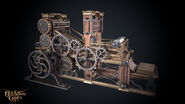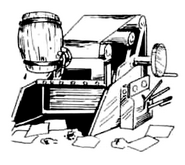A printing press was a mechanical device for applying ink to a surface such as paper.[2]
History[]
In Shou Lung, the printing press fell in and out of use, being invented and reinvented at least five times since the time of the Li Dynasty (−1029 DR to −670 DR). Each time, it was used to reprint copies of classic Shou books, but was forgotten again when demand dropped.[3]
In the mid–14th century DR, Emperor Kai Tsao Shou Chin of Shou Lung wished develop Shou literature and popular culture, and thus ordered the redevelopment of the printing press, now with both movable type and paper. It was used to reprint and distribute new books, even the wildly popular Romance of the Three Lords from T'u Lung. It was predicted printing press technology would never again be lost.[3]
In Faerûn, meanwhile, the technology remained crude and experimental in the early 1360s DR, producing poor-quality texts. They were only suitable for cheap and low-quality pamphlets, handbills, and flyers, while larger works were too expensive.[2] By this time the people of Lantan had developed their own simple, hand-operated printing presses, but chose to keep them a secret from the trading powers of the Sword Coast.[1]
The dwarf printer Forgemaster Inkstain shipped a printing press up from Dwarves' Deep and began a printing business in the city of Procampur in the Vast. In the Year of the Helm, 1362 DR, the lama Koja of Khazari visited Inkstain to discuss printing his new book, A History of the Tuigan. However, Inkstain quoted a price of 10,000 gold lions just for one copy, and 500 lions for extras, which Koja was unable to pay or raise the money for. Fortunately, the god Deneir, the Lord of All Glyphs and Images, appeared to Koja and granted him gems worth at least 10,000 gold pieces to pay for the costs of printing. Koja planned to have his book printed by Inkstain the next day.[2]
Use[]
Printing presses were useful for mass-producing texts and could replace the duties of a scribe or scrivener. They were unable to print magical texts, however, as the magic wouldn't stick to the page.[2]
A person who operated a printing press was called a printer.[2]
Appendix[]
Gallery[]
References[]
- ↑ 1.0 1.1 Ed Greenwood, Sean K. Reynolds, Skip Williams, Rob Heinsoo (June 2001). Forgotten Realms Campaign Setting 3rd edition. (Wizards of the Coast), p. 87. ISBN 0-7869-1836-5.
- ↑ 2.0 2.1 2.2 2.3 2.4 2.5 David Cook (February 1993). “Patronage”. In James Lowder ed. Realms of Valor (TSR, Inc.), pp. 125, 127–131, 135, 146. ISBN 1-56076-557-7.
- ↑ 3.0 3.1 3.2 Mike Pondsmith, Jay Batista, Rick Swan, John Nephew, Deborah Christian (1988). Kara-Tur: The Eastern Realms (Volume I). (TSR, Inc), pp. 14, 29. ISBN 0-88038-608-8.


